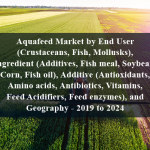OVERVIEW
The compound feed market is projected to reach USD 546.2 billion by 2024, rising at CAGR by 3.78% during the forecast period. The global market for compound feed is expected to grow rapidly due to an increase in the world’s consumption of animal-based food products over the forecast period. The improvement in dietary eating habits towards the quality of meat and dairy products is also expected to contribute to the growth of the compound feed industry.The compound feed market is projected to reach USD 546.2 billion by 2024, rising at CAGR by 3.78% during the forecast period. The global market for compound feed is expected to grow rapidly due to an increase in the world’s consumption of animal-based food products over the forecast period. The improvement in dietary eating habits towards the quality of meat and dairy products is also expected to contribute to the growth of the compound feed industry.








TABLE OF CONTENT
1 Global Compound Feed Market
1.1 Study Objectives
1.2 Market Definition
1.3 Study Scope
1.3.1 Markets Covered
1.3.2 Geographic Scope
2 RESEARCH METHODOLOGY
2.1 Research Data
2.1.1 Secondary Data
2.1.1.1 Key Data From Secondary Sources
2.1.2 Primary Data
2.1.2.1 Key Data From Primary Sources
2.1.2.2 Key Industry Insights
2.1.2.3 Breakdown of Primaries
2.2 Market Size Estimation
2.2.1 Bottom-Up Approach
2.2.2 Top-Down Approach
2.3 Market Breakdown and Data Triangulation
2.4 Research Assumptions
3 Global Compound Feed Market – Executive Summary
3.1 Market Revenue, Market Size and Key Trends by Company
3.2 Key Trends by type of Application
3.3 Key Trends segmented by Geography
4 Global Compound Feed Market – Comparative Analysis
4.1 Product Benchmarking – Top 10 companies
4.2 Top 5 Financials Analysis
4.3 Market Value split by Top 10 companies
4.4 Patent Analysis – Top 10 companies
4.5 Pricing Analysis
5 Global Compound Feed Market – Industry Market Entry Scenario
5.1 Regulatory Framework Overview
5.2 New Business and Ease of Doing business index
5.3 Case studies of successful ventures
5.4 Customer Analysis – Top 10 companies
6 Global Compound Feed Market – Market Forces
6.1 Introduction
6.2 Market Dynamics
6.2.1 Drivers
6.2.2 Opportunities
6.2.3 Challenges
6.3 Porters Analysis of Market
6.3.1 Bargaining power of suppliers
6.3.2 Bargaining powers of customers
6.3.3 Threat of new entrants
6.3.4 Rivalry among existing players
6.3.5 Threat of substitutes
7 Global Compound Feed Market – Strategic Analysis
7.1 Value Chain analysis
7.2 Product Life Cycle
7.3 Supplier and distributor analysis (Market share and product dealing strategies)
8 Global Compound Feed Market – By Ingredient (Market Size – & million/billion)
8.1 Cereals
8.2 Cakes & meals
8.3 By-products
8.4 Supplements
9 Global Compound Feed Market – By mode of Livestock
9.1 Ruminants
9.2 Poultry
9.3 Swine
9.4 Aquaculture
9.5 Others
10 Global Compound Feed Market – By Source
10.1 Plant-based
10.2 Animal-based
11 Global Compound Feed Market – By Form
11.1 Mash
11.2 Pellets
11.3 Crumbles
11.4 Others
12 Global Compound Feed Market – By Geography (Market Size – & million/billion)
12.1 Introduction
12.2 North America
12.2.1 US
12.2.2 Canada
12.2.3 Mexico
12.3 Europe
12.3.1 U.K
12.3.2 Germany
12.3.3 Italy
12.3.4 France
12.3.5 Spain
12.3.6 Rest of Europe
12.4 Asia-Pacific
12.4.1 China
12.4.2 Japan
12.4.3 India
12.4.4 South Korea
12.4.5 Rest of APAC
12.5 Rest of the World
12.5.1 South America
12.5.2 Middle East
12.5.3 Africa
13 Global Compound Feed Market – Entropy
13.1 New product launches
13.2 M&A’s, collaborations, JVs and partnerships
14 Global Compound Feed Market Company Profile (Key Players)
14.1 Market Share, Company Revenue, Products, M&A, Developments
14.2 Cargill
14.3 ADM
14.4 New Hope Group
14.5 Forfarmers
14.6 Alltech
14.7 Charoen Pokphand Food
14.8 Land O’lakes
14.9 Guangdong Haid Group
14.10 Feed One Co.
14.11 Nutreco
14.12 Company 11 & more
15 Global Compound Feed Market – Appendix
15.1 Sources
15.2 Abbreviations











